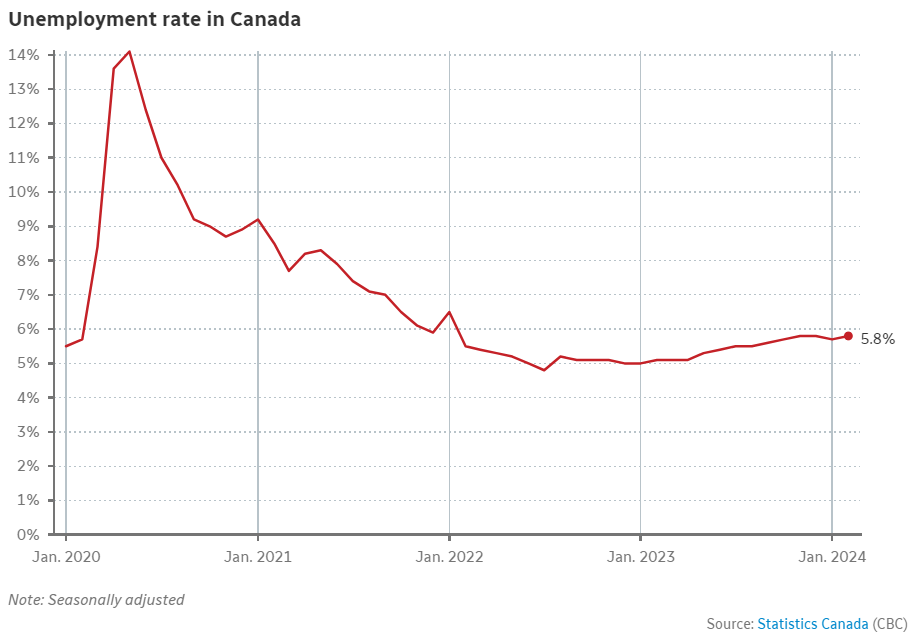Unemployment rose to 5.8 per cent, according to Labour Force Survey.

The Canadian economy added 41,000 jobs in February, fuelled by strong population growth that continues to outpace employment gains.
The federal agency’s labour force survey released Friday says the unemployment rate rose to 5.8 per cent, offsetting the decline recorded in January.
Job gains were spread across several industries in the services-producing sector, with the strongest employment growth in accommodation and food services.
Employment increased in Alberta and Nova Scotia, but declined in Manitoba. There was little change among other provinces.
High interest rates are putting a drag on the economy, as consumers pull back spending, causing a slowdown in sales for businesses. But strong population growth appears to be offsetting some of those effects, including in the labour market.
“Today’s report is certainly impressive at first blush, particularly the towering rise in full-time jobs,” wrote BMO chief economist Douglas Porter, noting that the headline number was roughly double what economists had predicted.
“However, it’s staggeringly clear that the results are flattered by ongoing massive population gains, and the labour market is thus actually gradually cooling,” he added.
Porter wrote that while all the job gains were in full-time work, these were driven by an increase in public sector jobs. Private sector jobs fell by 16,000.
“On balance, this will not change the Bank of Canada’s worldview.”

Women earned $0.87 for every $1 made by men
Women accounted for 47.3 per cent of Canada’s workforce in February.
The Labour Force Survey noted that a gender wage gap has narrowed over the years but remains persistent, with women in the core age group (25 to 54) earning $0.87 for every dollar earned by men in the same demographic in February.
The gap is more pronounced in male-dominated sectors, like manufacturing and utilities, and natural resources.
The employment rate for core-aged women was highest in Quebec (85 per cent), New Brunswick and Nova Scotia (both 82.5 per cent), above the national average of 81.4 per cent.

Employment rate fell for 5th consecutive month
High population growth has added more consumers and workers to the economy, allowing for ongoing job gains in the country.
But other measures of employment paint a weaker picture of the labour market.
Statistics Canada has been putting more emphasis on the employment rate in its reports recently to capture whether job gains are keeping up with population growth.
The federal agency notes in Friday’s report that the employment rate — which represents the proportion of Canadians aged 15 years and older who are employed — fell for a fifth consecutive month in February.
That’s the longest period of consecutive decreases since the six-month period ending in April 2009.
Meanwhile, wages continue to grow rapidly in Canada. Average hourly wages were up five per cent from a year ago, down from a rate of 5.3 per cent in January.
With files from CBC’s Jenna Benchetrit
*****
Credit belongs to : www.cbc.ca
 Atin Ito First Filipino Community Newspaper in Ontario
Atin Ito First Filipino Community Newspaper in Ontario






